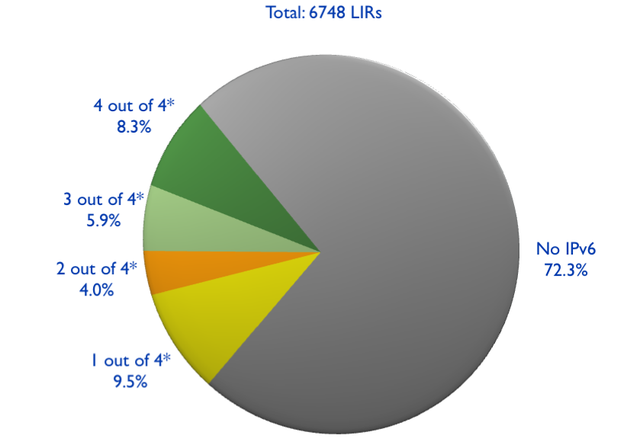We looked at all LIRs registerd in the RIPE NCC service region and determined their home country based on their Reg-ID (country-code.name).
We would like to adjust our LIR IPv6 Training Course depending on the country we 
We created a rating system, in which LIRs can get up to four “stars” for IPv6 services, depending on the following criteria: IPv6 allocation, visibility in the Routing Information Service ( RIS ), route6 object in the RIPE Database and reverse DNS delegation set up.
Overall, 8% of LIRs have achieved four-star IPv6 RIPEness. Please find below more detailed results and a description of the methodology used.
Detailed Results
The graph below shows the percentage of LIRs with zero to four stars for each country in the RIPE NCC service region that has five or more LIRs. This provides an indication of the level of IPv6 deployment in a specific country and in the RIPE NCC service region as a whole.

Figure 1: Level of IPv6 deployment per country (April 2010)
The graph shows that 27% of all LIRs in the RIPE NCC service region have at least one IPv6 allocation. And 8% have achieved four-star IPv6 RIPEness.
Slovenia shows the best results: 67% of LIRs in Slovenia have at least one star, while 25% have four stars! In absolute numbers that means 8 out of their 34 LIRs have achieved four star IPv6 RIPEness.
The bad news is that, overall, almost three quarters of all LIRs (indicated by the white bars on the graph) have not even requested IPv6 space yet. That is why we are targeting our IPv6 courses for LIRs to those countries with the smallest IPv6 ripeness ratings. The results of this study help the RIPE NCC to adjust the course material to the levels of IPv6 deployment in a given country.
Please watch also the IPv6 ripeness movie that shows the IPv6 RIPEness ratings over time for the period between January 2004 and May 2010.
Methodology
We looked at all LIRs registered in the RIPE NCC service region and determined their home country based on their Reg-ID (country-code.name). We realise that the actual location, or even some of the services the LIR provides, might be in a different country, or in multiple countries.
In order to earn the first star, an LIR must have received an IPv6 allocation, or a PI assignment. Requesting IPv6 address space and fulfilling the criteria for an initial allocation is relatively easy: the organisation simply has to “have a plan for making sub-allocations to other organisations and/or End Site assignments within two years.”
Additional stars can be earned if:
- The IPv6 prefix is visible in the Routing Information System . For us, this means that the prefix is announced; it can happen, though, that address space is announced to peers and upstreams, but is still not visible in RIS.
- A route6 object for the IPv6 prefix is registered in the RIPE Database. Note that this is not absolutely necessary for deploying IPv6, but it is a measure of good housekeeping. Some transit providers or Internet Exchange Points use route(6) objects as a requirement for accepting customers or peers. The RIPE NCC Routing Registry training course explains this in detail.
- Reverse DNS is set up for the IPv6 prefix. This is not strictly necessary for a working IPv6 service, but it is seen as good practice.
If an LIR has multiple IPv6 address allocations, de-aggregated prefixes, multiple route6 objects or less specific reverse DNS delegation, that LIR would still only receive one star in each category in the rating system.
In order to anonymise the results, we decided to only show countries that have more than five LIRs.
Please also note that this rating system does not guarantee that an LIR that has four stars has a working IPv6 setup. On the other hand, an LIR that has one star only (that means it has an IPv6 allocation but does not fulfill any of the other criteria) may very well have a functioning IPv6 network (just hasn't done very good housekeeping... yet).
All measurements are based on data in the Internet Number Resource Database ( INRDB ).
Fifth Star
We wish to complete our rating with a fifth star based on reachability. We have several ideas, but we are curious to hear from you – what do you think is a good way to measure reachability? Here are some suggestions:
a) ping the "pingable" address in the route6 object as proposed in
http://www.ietf.org/id/draft-haberman-rpsl-reachable-test-04.txt
The advantage of this approach is that the measurement is neutral and objective. The disadvantage is that the existence of the pingable attribute is voluntary, and even the registration of a route6 object is not strictly necessary for fully deploying IPv6. In addition, this attribute is not yet implemented in the Routing Policy Specification language (RPSL).
b) observe addresses from the allocated IPv6 range connecting to www.ripe.net (during certain time period)
The advantage of this method is that no extra effort is needed from LIRs. The disadvantage is that not everyone may connect to www.ripe.net during the measurement period.
Next steps
As a next step we are considering assigning badges for those LIRs that have 4 stars. They could be shown next to the LIR's name on the RIPE NCC's web site. This might act as an encouragement for other LIRs to get their houskeeping in order and earn more stars.
We are also considering including this information in the LIR Locator tool .
Questions to you
We would like to hear from you what you think about this rating system in general. Please consider the following questions specifically:
Do you agree that we tag your LIR's name with the “IPv6 RIPEness" badge?
Which reachability criteria do you prefer for the fifth star?
The first 50 LIRs with “Four Star IPv6 RIPEness” that write to us at ncc@ripe.net (subject: IPv6 RIPEness), will receive one T-shirt of your choice (and size) – either RIPE Labs, or IPv6ActNow .







Comments 4
The comments section is closed for articles published more than a year ago. If you'd like to inform us of any issues, please contact us.
Anonymous •
<div class="content legacycomment"> <p> This is interesting, thanks for sharing. I have a couple of comments. </p> <p> </p> <p> 1) On the fifth star - combining multiple measurement techniques is probably the right approach here. </p> <p> </p> <p> 2) I'm not sure that focussing most on 'unripe' countries is necessarily the right approach. I tend to favour an approach that takes account of the absolute number of 'unripe' LIRs per country and prioritises accordingly. </p> <p> </p> <p> Thanks again, this is good work, </p> <p> </p> <p> Mat </p> </div>
Anonymous •
<div class="content legacycomment"> <p> First of all, this IPv6 "rating" is good stuff imho! </p> <p> </p> <p> Regarding the assessment for awarding the 5th star - I don't think the two mechanisms, as proposed, are mutually exclusive. My feeling is that it is perfectly OK to look at the source addresses of website visitors and match that up with the allocations. </p> <p> </p> <p> The idea of publishing a "ping6able" address is attractive, technically and at first glance. Although - wearing my security hat for a moment - publishing such an address might attract DoS traffic? Caveat: 'I still have to read the draft, and it all depends on implementation </p> <p> </p> <p> Talk to you soon regarding some other IPv6 measurement stuff ideas, </p> <p> </p> <p> Wilfried </p> </div>
Anonymous •
<div class="content legacycomment"> <p> Inspired from Hurricane Electric ipv6 "certification" system: </p> <p> </p> <p> Gain a fifth star for: </p> <p> - having a v6 reachable email contact in whois (address information already present in ripedb) </p> <p> - having a v6 reachable website (try to guess a website from the email contact domain? provide an interface for the LIR to specify further information for tests but not making these public?) </p> <p> - reverse dns nameservers have v6 records and are pingable through v6 and actually respond to v6? </p> <p> </p> <p> What about partial stars, like 4.5 stars if not all requirements for the fifth star are met? </p> </div>
Anonymous •
IPv6 ripeness is mentioned in the IETF draft:<br /><a href="http://tools.ietf.org/html/draft-kawamura-ipv6-isp-listings-00" rel="nofollow">http://tools.ietf.org/[…]/draft-kawamura-ipv6-isp-listings-00</a><br />"A Basic Guideline for Listing ISPs that Run IPv6"<br />